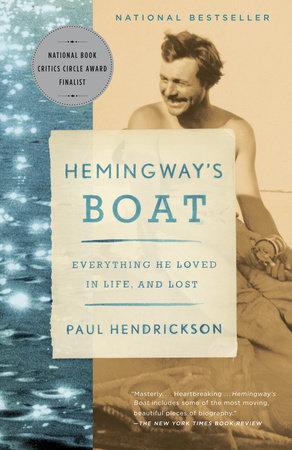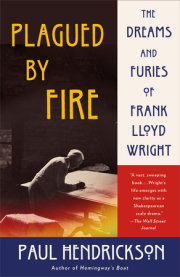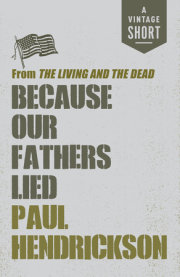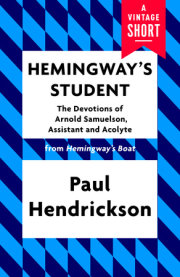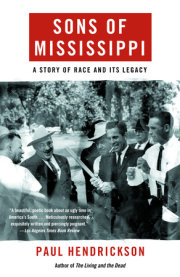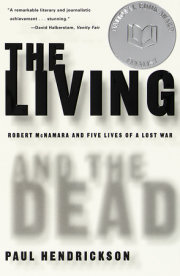AMERICAN LIGHT
APRIL 3, 1934. The temperature in Manhattan got into the high sixties. G-men shot an accomplice of Dillinger's in Minnesota; the Nazis were running guns to the Moors; Seminoles were reviving a tribal dance in honor of alligators in Florida; Lou Gehrig had two homers in an exhibition game in Atlanta. And roughly the bottom third of America was out of work.
According to "Steamship Movements in New York," a column that runs daily in the business section of the Evening Journal, nine liners are to dock today. The SS Paris, 34,500 tons, is just sliding in after a seven-day Atlantic crossing, from Le Havre via Plymouth, at Pier 57 on the West Side of New York City.
"Expected to dock: 5:00 P.M.," reports the newspaper. And she does.
If this were a Movietone News item about Hemingway the big-game hunter, arriving home after eight months abroad, and you were in a darkened movie palace of the thirties awaiting the feature, you'd see ropes being thrown off, gangplanks being lowered, steamer trunks being unloaded, and passengers starting gaily to stream off. You'd see the New York press boys with their rumpled suits and stained ties and skinny notebooks and Speed Graphic cameras clawing for position. The blocky white lettering superimposed on the flickering images would announce: "Back from Lion Hunt in East Africa!" They'd bring up the sound track-something stirring, to suggest the march of time. And then would come the voice-over-wouldn't it be Ed Herlihy's?-with its electric charge: "Famed author Mr. Ernest Hemingway, just back on the French liner Paris with Mrs. Hemingway from conquering the lion and the rhino and the wildebeest and the greater kudu, says that death in the afternoon is far less engrossing in a Spanish bull ring than on the African veldt."
The press boys clotted at the bottom of the gangplank badly want Hemingway, and they want Katharine Hepburn (she is on the boat, too, and makes wonderful copy, when she deigns to speak), but apparently none of them knows (for none of their papers will have it tomorrow) that an even bigger trophy has just berthed at Pier 57: Marlene Dietrich. She's going to give them the nifty slip. Publicity? Who needs it? Maybe Dietrich's hiding out in her stateroom. She might have registered under a different name-glamorous figures routinely do this. In fact, Hepburn is on the manifest as "Miss Katherine Ludlow." (Her husband is Ludlow Ogden Smith.) She has decided not to hide from the pack.
The famous and close and long-lasting Dietrich-Hemingway friendship dates from this Atlantic crossing. For the rest of his life, Hemingway mostly called her the Kraut, when he wasn't addressing her as "daughter," the latter being how he liked to address women younger than himself, famous or otherwise, whom he'd not-apparently-taken to bed. Dietrich was two and a half years younger. There is a well- traveled story about how she was stepping into the ship's dining room to join a dinner party. Every open-jawed man at the table rose to give her his chair, but just as she started to sit down, the international flame with the statuesque body and lusty voice counted the mouths and saw that there were twelve diners. "Oh. I'm the thirteenth. You will excuse me if I don't join you. I'm superstitious about thirteen at dinner," she said, starting to withdraw. But just then Hemingway blocked her way. "Excuse me," he said. "I don't mean to intrude. But I'd be glad to be the fourteenth."
Afterward, they supposedly strolled the decks arm in arm and told each other-maybe like Bogart and Claude Rains in Casablanca, except that that movie hadn't been made yet-that this was going to be the start of a beautiful friendship. At least this is the legend, and Dietrich herself greatly helped it along in 1955 in a first-person cover story in the Sunday supplement of the New York Herald Tribune. The piece was titled "The Most Fascinating Man I Know." She talked of how she and Hemingway had depended on each other through the years, how she'd protected his deeply personal letters to her in a strongbox. Actually, Dietrich may not have even written the piece- according to Mary Hemingway, it was ghosted by journalist and scriptwriter A. E. Hotchner, one of Hemingway's last confidants, or toadies, depending on your point of view, for the two-decades-younger Hotch, as Hemingway often called him, has been described as both in the vast, roily, envy-ridden sea of Hemingway studies. In any case, among smaller errors, Dietrich or her ghost got the name of the boat wrong; she said it was the other (even grander) star of the French line, the Île de France.
But this is a newsreel of the imagination. Hemingway's poised at the
Paris's rail with his spouse. He's intent on purchasing a boat, but right now he's allowing photographs to be made, and he's popping quotes. Freeze the frame. Stop time in a box.
Pauline Hemingway is in a zebra-striped suit and an almost dowdy hat, curled at the brim, tilting right to left. Her right shoulder touches her husband's left. She is so small beside him. Her hair is cropped like a boy's. She has a boyish physique and is known for her disinclination to use makeup. (It's true she likes to keep her nails and toes manicured for her husband, often lacquering them in light pink.) Her body is turned a few degrees away from the rail, as if she might decide to walk off any second now. She's probably not getting a word in edgewise. She isn't a beautiful woman, but she isn't unattractive, either. She is four years and a day older than her husband, who is leaning forward, right into the middle of things, as if right into the middle of reporters' notebooks. Both his arms are on the rail, and his right hand is holding the brim of a fedora that has a wide, dark band. He's wearing a suit and tie and there's a sliver of handkerchief visible at the top of his vest pocket. No matter his dress, he's unmistakably a man of the outdoors, with the body of an athlete. His hair looks Brylcreemed and newly cut, although a strand or two at the back of his head are out of place. Around his seventeen-and-a-half-inch neck, inside his dress shirt, is a scapular: he's a convert to Catholicism, which is his wife's devoutly practiced faith. (She's a "cradle Catholic," while his on- again, off-again devotions are reputed to have arisen out of the shocks of World War I.) He's known to wear his scapular unfailingly in these years. It's got an image of Christ on it, suspended from a brown, shoestring-like loop. At home, in Key West, friends have observed him with the scapular, and how he'll make the sign of the cross before he goes in swimming.
That smile: hobnailed and hard-boiled all the way, just this side of aggressive. The more you study the photograph, however, the more you see that both Hemingways are holding a pose.
This picture, or versions of it, is going to get picked up and run in many hinterland places, including in the Twin Cities of Minnesota, where winter still has the earth in her grip, and where a young, self- styled, Hemingway-like character will see the photograph and tear it out of the Pioneer Press and fold it into his pocket and pack his knapsack and hop a freight to Florida, in hopes of meeting his writing idol. The young man's name is Arnold Morse Samuelson, and he is in for the ride of his life. But that's running out ahead.
Not every city editor in New York-there are something like nine dailies in the city in 1934-has sent a reporter to the docks today to shag quotes and to compose deathless passages on deadline about the return of the native. (In the old days of the news business, these pieces were often known as "brights." Go get me a Hemingway bright, some pale, overweight editor at the Times surely growled at a reporter on the city desk.) And what is the "fascinating man" saying to the press boys? He's telling them how he gives first honors to the leopards, "because they strike the fastest." But the lion is such a noble beast, too, he says. "He is not afraid or stupid. He does not want to fight, but sometimes man makes him, and then it is up to the man to shoot his way out of what he has got himself into." With the lion and the leopard, "you're either quick or you're dead. I saw a lion do one hundred yards in three seconds flat, which may give you an idea." The hunter saw ninety-six lions altogether and at one point he photographed twenty-nine lionesses "preening themselves like a group of finishing school girls." He made a moral bargain with himself to bring down only animals that were utter strangers to him; the lions that he'd stalked with his camera he could somehow not force himself to shoot. But now he intends to return to his home in Key West and resume his vocation. His season of intense writing, he hints, may or may not concern Africa.
The World-Telegram will have a seven-grapher tomorrow, page 11 ("Jungle Praised by Hemingway"). The lead:
Ernest Hemingway, author_._._._is back home and "nearly broke" after eight months abroad, three of which he spent on the "dark continent." The trouble with bull-fighting, in the opinion of the man who admits he knows so little about it that he wrote a book on the subject, is simply that it's too formal. Like all invitation affairs, he holds, it has a plethora of rules. Out in the brush where the hunter fights for a clawhold with his prey as man to beast-and no rules committee in the offing-it's more fun.
The Herald Tribune's subhead on its Hemingway bright (eleven paragraphs, page 4): "Author, Back from African Hunt, Says He Never Shot Beasts Trailed for Camera." The lead: "Ernest Hemingway, enthusiastic over the three months he had passed in East Africa stalking big game with rifle and camera, returned yesterday on the French liner Paris with Mrs. Hemingway, who shared his adventures. Mr. Hemingway was in such high spirits that he granted an interview, something unusual for him."
The subject's first quote: "It's hard to describe just what there is to killing big game. It's very exciting and-uh-it gives you a fine feeling. It's the sort of the same thing as any killing; that is, it's fine, if you do a clean job of it and it's lousy if there's bad sportsmanship." Toward the end: "The pursuit of game having renewed his enthusiasm for life, he returned home 'to work like hell and make enough money so that I can go back to Africa and really learn something about lions.' "
It must be the Herald Trib's account that E. B. White of The New Yorker catches on his way to work on the morning of the fourth. The Herald Trib is the highbrow newspaper of choice in Manhattan, and these quotes are apparently just too much for a domesticated literary man. Because the following week, a three-stanza Hemingway send-up titled "The Law of the Jungle" appears on page 31 of The New Yorker. White's final lines:
And who, in time of darkest danger
Will only dominate a stranger.
Seventeen years from now, on the publication of Hemingway's weakest novel, Across the River and into the Trees, White, great American humorist, never a white hunter on the dark continent, will bring down Hemingway again in the magazine with a parody titled "Across the Street and into the Grill." By then parodying Hemingway will have become a cottage sport and pastime in America. White's piece will particularly enrage the author, perhaps because he instantly understands that it will get into anthologies and live way past his own death.
What was Ernest Hemingway's interior state when he stood at the Paris rail with his petite and affluent spouse on the eve of acquiring Pilar? (Pauline's uncle, Gus Pfeiffer-a New York businessman, part of whose fortune had been derived from his interests in a Paris and Manhattan perfumer named Richard Hudnut, and who liked Ernest a good deal, at least then-had staked the safari somewhere to the bottom line of about $30,000. The safari had lasted just a little over two months, not three, as was reported. Hemingway had been in Africa for nearly three months, but not in the bush for that long, and for about a week of the actual safari he was confined to a hospital bed in Nairobi, having suffered an attack of amoebic dysentery that necessitated evacuation by light plane.)
A whole lot of his state of mind can be glimpsed in his writing, not least his letter writing. Hemingway wrote somewhere between six and seven thousand letters in his life, by hand and by typewriter and by dictation, usually in free-associative bursts, often after a day's writing, to relieve tension, more or less in the way you'd speak in a conversation. This is particularly true of his letters to friends and to certain family members. "The desire to get to the man behind the work can be sometimes overwhelming. I always go back to the letters," Patrick Hemingway told me in 1987, a sentence that seems only truer with time.
Hemingway's momentary high spirits in early April 1934 must have had at least two prongs: he was back from his excellent safari adventure; and now, before heading home by train to Florida, he hoped to go to a Brooklyn boatyard and put in an order for his own longed-for fishing machine. And yet, what his letters, cojoined with verifiable facts of his life just then, suggest is that what might have seemed so clear in a photograph and in what he told some shipside reporters didn't nearly reflect what Hemingway was generally feeling inside. Every good photograph has a secret, a critic named Mark Stevens once wrote: "Something mysteriously and tantalizingly withheld, even when the world seems laid out as plainly as a corpse upon a table."
One verifiable truth is that the monarch of American letters had been riding through rough critical seas for the last few years-and much more rough going was up ahead. Somehow, nothing seemed quite as locked as it once did, and that included owning the reviewers. Not quite a year earlier-on June 13, 1933-the author for whom things had once seemed to come so effortlessly had written to his book editor: "I am tempted never to publish another damned thing. The swine arent worth writing for. I swear to Christ they're not. Every phase of the whole racket is so disgusting that it makes you feel like vomiting._._._. And it is a commonplace that I lack confidence that I am a man-What shit-And I'm supposed to go around with your good friends spreading that behind my back-And they imagine they will get away with it." He'd been referring specifically in this instance to his former friend Max Eastman (a fellow Scribners author), who'd just written a half-joking and belated review of Death in the Afternoon for The New Republic titled "Bull in the Afternoon." The Hemingway style, Eastman said, was that "of wearing false hair on the chest." In Hemingway's reading, and in the reading of some of his close friends, the piece wasn't trying to be humorous at all but rather was making overt suggestions to the effect that Hemingway must feel sexually inadequate. Well, he'd break Eastman's jaw the next time he saw him, and sell tickets to the event.
One way to read Ernest Hemingway's life is through the phenomenon of remarkable first luck. He'd become an international literary figure, specifically as a novelist, so quickly-in the second half of the 1920s, less than a decade from when he'd started out. He'd started out with stories-actually, sometimes just intensely felt imagistic fragments of stories.
Copyright © 2011 by Paul Hendrickson. All rights reserved. No part of this excerpt may be reproduced or reprinted without permission in writing from the publisher.

